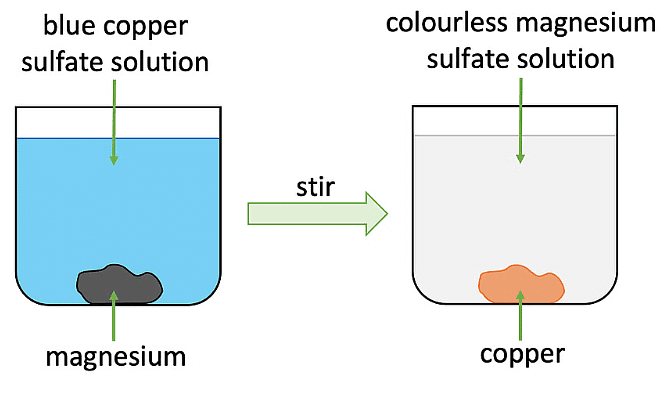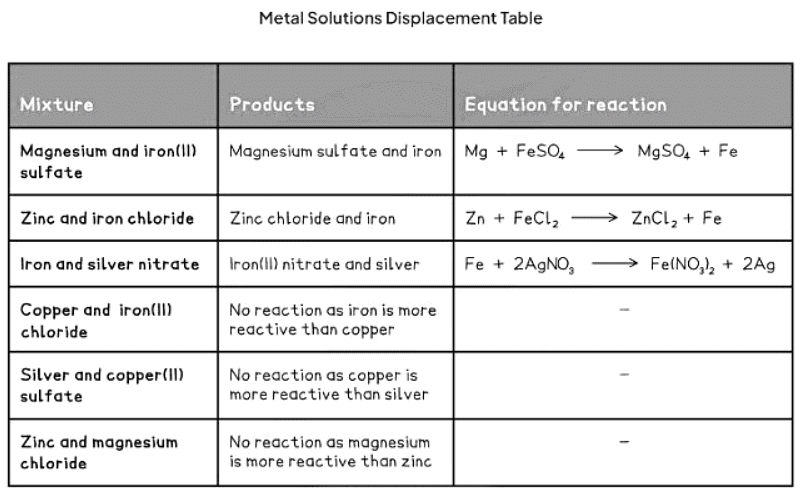Class 10 Exam > Class 10 Notes > Chemistry for GCSE/IGCSE > Explaining Reactivity
Explaining Reactivity | Chemistry for GCSE/IGCSE - Class 10 PDF Download
Explaining Reactivity
- When metals react with other substances, they form positive ions due to electron loss
- The reactivity of a metal is determined by its propensity to lose electrons
- A metal positioned higher in the reactivity series easily sheds electrons, showcasing higher reactivity compared to metals lower in the series
Displacement Reactions
- In displacement reactions between metals and aqueous solutions of metal salts, a more reactive metal displaces a less reactive metal from its salt solution
- For instance, when iron (Fe) is placed in a copper sulfate (CuSO4) solution, the iron displaces copper and forms iron sulfate (FeSO4) while copper is deposited
- This demonstrates the reactivity series in action, with more reactive metals displacing less reactive metals in solutions
- Any metal can displace another metal positioned lower in the reactivity series from a solution of one of its salts. This displacement phenomenon occurs because more reactive metals have a higher tendency to lose electrons and form ions compared to less reactive metals. Consequently, more reactive metals serve as better reducing agents.
- This reactivity trend is attributed to the fact that the less reactive metal acts as a superior electron acceptor when compared to the more reactive metal. Hence, the less reactive metal undergoes reduction in this process. Remember, according to the mnemonic OIL-RIG, reduction involves the gain of electrons.
Question for Explaining ReactivityTry yourself: What determines the reactivity of a metal?View Solution
Example
- Let's consider an example involving magnesium and copper sulfate. Magnesium, being a reactive metal, can displace copper from a copper sulfate solution.
- Magnesium exhibits a higher tendency to lose its electrons, leading to the ion of the less reactive metal, copper, accepting these electrons to form elemental copper. This reaction is visually evident as the more reactive metal gradually vanishes from the solution, displacing the less reactive metal.
- Magnesium displaces copper from a copper sulfate solution due to its higher reactivity.
- Magnesium's electron loss facilitates the transformation of copper ions into elemental copper.
- The displacement of copper by magnesium becomes apparent as the more reactive metal disappears, replacing the less reactive metal in the solution.
- The chemical reaction demonstrating the displacement of copper by magnesium in a copper sulfate solution results in the formation of magnesium sulfate and elemental copper. This can be symbolically represented as:
Mg (s) + CuSO4 (aq) → MgSO4 (aq) + Cu (s) - The blue color of the copper sulfate (CuSO4) solution fades as colorless magnesium sulfate solution is formed.
- Copper coats the surface of the magnesium and forms a solid metal that falls to the bottom of the beaker.
- Diagram showing the color change when magnesium displaces copper from copper sulfate:

- By combining different metals and metal salts solutions, it is possible to determine a relative reactivity order.

- From the displacement table, we can deduce the order of reactivity:
- Magnesium and zinc are more reactive than iron, with magnesium being more reactive than zinc.
- Copper and silver are less reactive than iron, with silver being less reactive than copper.
- The order of reactivity of the metals tested: Mg > Zn > Fe > Cu > Ag.
Reactivity of Aluminium
- Aluminium is high in the reactivity series, but in reality, it does not react with water and the reaction with dilute acids can be quite slow
- This is because it reacts readily with oxygen, forming a protective layer of aluminium oxide which is very thin
- This layer prevents reaction with water and dilute acids, so aluminium can behave as if it is unreactive
The document Explaining Reactivity | Chemistry for GCSE/IGCSE - Class 10 is a part of the Class 10 Course Chemistry for GCSE/IGCSE.
All you need of Class 10 at this link: Class 10
|
72 videos|162 docs|61 tests
|
FAQs on Explaining Reactivity - Chemistry for GCSE/IGCSE - Class 10
| 1. What is reactivity in the context of displacement reactions? |  |
Ans. Reactivity in the context of displacement reactions refers to the ability of an element to displace another element from a compound in a reaction. Elements with higher reactivity are more likely to replace elements with lower reactivity in a compound.
| 2. How is reactivity determined in displacement reactions? |  |
Ans. Reactivity in displacement reactions is determined by the position of an element in the reactivity series. Elements higher in the reactivity series are more reactive and can displace elements lower in the series from a compound.
| 3. What are some examples of highly reactive elements in displacement reactions? |  |
Ans. Highly reactive elements in displacement reactions include alkali metals like sodium and potassium, as well as halogens like fluorine and chlorine.
| 4. How does reactivity affect the rate of displacement reactions? |  |
Ans. Elements with higher reactivity will react more readily in displacement reactions, leading to a faster rate of reaction compared to elements with lower reactivity.
| 5. Can reactivity be predicted in displacement reactions? |  |
Ans. Yes, reactivity can be predicted by referring to the reactivity series, which lists elements in order of their reactivity. Elements higher in the series are more likely to displace elements lower in the series in a displacement reaction.
Related Searches















